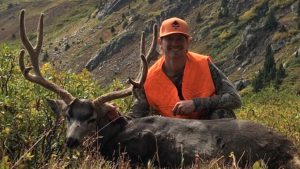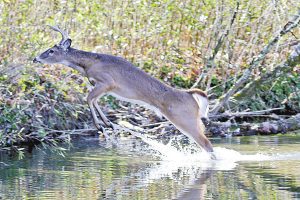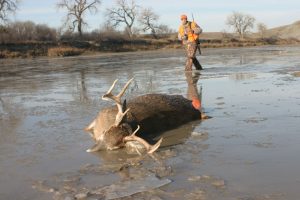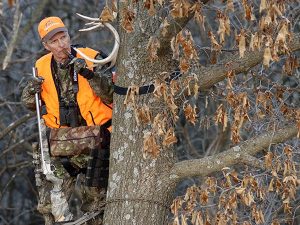
Now if you are a hunter or new to hunting the very first knowledge is not just going out to the woods with a gun and shot a deer down. As much as coordinating a state or a project needs execution of a plan, so does a deer hunting. Let’s say you and your friends decided to leave the busy lifestyle of the city and out to embrace the wilderness of the nature for a few days. One of your excursion itinerary includes Deer hunting and you must be wondering how would it be like to hunt a deer.
It’s not a cliché a big deer didn’t get to be big by being stupid, he knows the game. He knows what it takes to be big to limp to maturity and what does this mean? It means when he gets older, his roaming territory shrinks. Why is that? Because he knows where he’s safe he knows where he can get what he needs, where he can get food. water and breeding opportunities.
How can you find these deer? A new piece of gear, a new piece of tree stand helps but that’s not how you find the deer, that’s not how you get in position to kill these deer. You have to know a deer to be able to hunt one. You have to know their nature to know how to hunt them successfully.
One thing to remember, deer hunting could be daunting but you need to have patience, know a few skills, learn the pinch points all of which will come in aid to your hunting experience. Yes, you will come across a lot of thoughts but you need to brainstorm a few ideas and make sure you’re geared up before you embark on your kill. You must know the suitable destination and the time year for deer hunting. Always maintain safety measures and then you can aboard on your mission.
Here are a five funnel techniques and pinch points to consider that’ll assist you hunting a deer
Hillside Gully
To hunt a deer several aspects of its habitat should be monitored such that the hunter gets a clear view from where he or she would get a clear shot. The hunter should have enough visibility on the pinch points.
For instance, an elevated positioning or a tree stands avails a better field view which allows better deer-shots. Obviously to make funnels for deer movement requires careful scouting of the hunting area. This is a traditional method as most hunters finds it effective, as it keeps the aim well and aware within range.
The terrain feature has a great influence on the deer as they can be spotted wandering around the gully, usually water washes out from the hill and your best shot could be from this prime spot.
Outcropping Side

Hunters are always on the lookout for best stand spots, one of which is the rocky outcropping – a down sloping corridors.
It is one ideal sight for a hunter to scout for a deer.
Usually deer are seen walking alongside these pathways. These outcropping is incremental simply because they force deer movement on either side of the hill. This is called macro-level funnel finding and it is a great spot during the season.
Wetlands

Deer can be spotted on lands saturated with water, either edge of a lake, marshes or ponds and swamps, where they don’t mind getting themselves muddy or cooling themselves off.
A highland ridge is one of the best funnel for deer. You can also bait the deer with some food at the edge but you are likely to find a pounded deer trail.
Just have your hunting crossbow ready and it is important to remain concealed and as motionless as possible for deer are quite intelligent and may notice your presence.
So, to hunt them successfully a wetland funnel with a narrow point with an elevated ridge gives makes a travel route between the high grounds through which a kill is possible.
Creek or River crossing

Creek or river crossing is an amazing place for hunting deer. This is one spot hunters often camp on, where you can come across a deer. Steep slope of the river bed or just the right run after a deep pool in a creek can lure deer to cross precisely there. The crossing of the deer around the banks of the creek or the river is an advantage for any hunters in action. Deer needs to drink water every day and it gets even better if you are camped next to a large river. It is not easy for a deer to cross the river on a whim which is one the other hand a better pinch point than ridge.
But deer mostly love traveling along river and if they don’t these ridges force their movements towards the banks. If you have running water on your deer ground, scout its length and identify all the crossings. It’s very often the terrain has an influence on the locomotion of the deer resulting an exclusive stand site for hunting.
Cropland

Now if you are out on a large land surrounded by crop field, it’s wise to look for hunting areas via GPS for aerial photos. An ideal spot should be two fields that is divided or separated by a thin strip of cover. Deer use those covers to camouflage themselves and move from one point to another.
This an ideal time of the hunting season when the deer sighting is found. It is an amazing funnel for deer movements as it subsequently creates a rut. Therefore, a terrain feature formed that forces the deer to travel a certain way.
It also forces all the deer in all times of the season not only during the hunting period. For if you are a hunter and out for a kill, you are about to get close and consistent season long action. Agricultural feeding areas are usually one of the pinch points you can bank.
Now you and your friends can sit by the campfire, discuss on your stand sites and find those pinch points, hunt using those funnels. And we can almost guarantee you and your friends will enjoy some of the best rut hunting action of your life. Last but not least always be careful about your safety. Hunting requires patience and little bit of skill. Whether hunting for survival or hunting as a spot, you need to know that you are in legal grounds to hunt. Happy Deer hunting!


